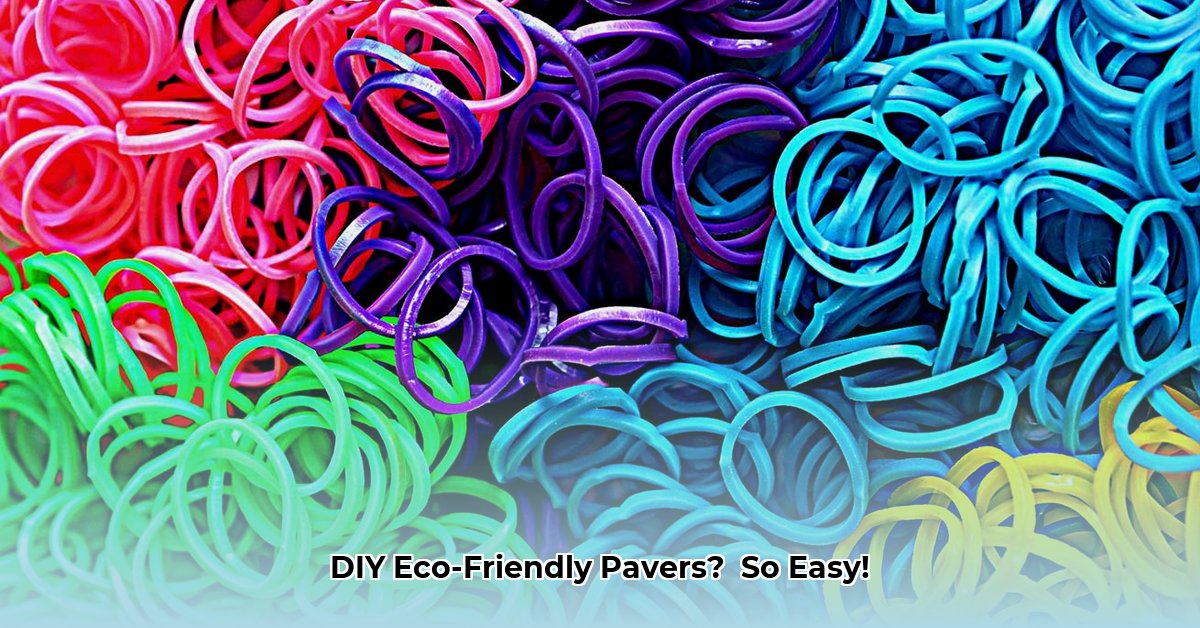Thinking about giving your outdoor space a makeover? Rubber pavers present an excellent DIY-friendly and eco-conscious alternative. This comprehensive guide takes you through selecting, installing, and maintaining rubber pavers, ensuring a beautiful and sustainable result. For more deck tile options, check out these rubber deck tiles. Let’s dive in and explore how you can transform your space with this versatile material.
Rubber Pavers: Your Eco-Friendly DIY Patio Project
Considering a new patio? Ditch the heavy concrete work! Rubber pavers are an environmentally friendly option that’s surprisingly easy to install yourself. Let’s examine why they’re gaining popularity and guide you through the whole process, from start to finish. Explore the best rubber pavers for patios, walkways, driveways, and even sloped areas.
Why Choose Rubber Pavers? A Greener, Easier Choice
With increasing environmental awareness, rubber pavers have emerged as a leading choice. Crafted from recycled rubber tires, they offer a sustainable alternative to materials like concrete or stone. By choosing rubber pavers, you’re repurposing old tires and minimizing landfill waste, a win-win scenario for your conscience and the planet.
Rubber pavers are available in various styles, colors, and textures, including flagstone patterns, brick looks, and contemporary designs. Tailor your patio to your home’s style and personal preferences. Rubber pavers provide a sustainable and visually pleasing option for any outdoor space at an affordable cost, enhancing both your home’s appeal and its environmental footprint.
Their resilience is another notable advantage. Unlike concrete, which can crack under pressure or extreme temperatures, rubber pavers are remarkably resistant. You likely won’t see fading or damage from freezing and thawing cycles, making them a sound long-term investment and a rewarding weekend DIY project.
Picking the Perfect Pavers: A Comprehensive Guide
Choosing the right pavers is the first step to a successful patio project. Here’s what you should consider:
- Thickness: Thicker pavers are tailored for high-traffic zones such as driveways, offering increased support and durability under heavier loads. They can withstand the weight of vehicles and frequent use without compromising their integrity. Thinner pavers may work well for patios and walkways, reducing expenses without sacrificing quality for less demanding applications.
- Style and Look: From classic brick patterns to natural stone imitations and modern geometric designs, you’ll find a design that complements your home’s architecture and enhances your outdoor decor. Rubber pavers offer incredible flexibility in achieving your preferred outdoor aesthetic, allowing you to create a cohesive and stylish space.
- Color Palette: Rubber pavers come in a wide spectrum of colors, from neutral earth tones that blend seamlessly with nature to bolder hues that make a statement. Consider colors that enhance your landscaping, complement your home’s exterior, and create a cohesive and visually appealing outdoor space.
- Size and Shape: Pavers are available in various sizes and shapes, including squares, rectangles, and interlocking designs. The size and shape of the pavers can significantly impact the overall look and feel of your patio. Larger pavers can create a more modern and spacious feel, while smaller pavers can add texture and detail.
- Texture and Grip: Consider the texture of the pavers, especially if you live in an area with frequent rain or snow. Pavers with a textured surface provide better grip and prevent slipping, ensuring safety for you and your guests.
- Permeability: Some rubber pavers are designed to be permeable, allowing water to drain through them and back into the ground. Permeable pavers can reduce runoff and help to prevent flooding, making them an environmentally friendly choice.
Take your time researching different suppliers and comparing costs to find the best option for your specific project needs and budget. Check local home improvement stores, specialty paving retailers, and online retailers to explore the full range of available options.
Preparing the Ground: Laying a Solid Foundation
Before laying down pavers, you need to prep the ground meticulously. A solid, level base is essential for a lasting, beautiful patio. Here’s how to get started and create the perfect base and foundation:
- Clear the Area: Remove any grass, weeds, rocks, or debris from the area where you’ll install your patio to create a clean, even surface. This will prevent any organic matter from decomposing under the pavers and causing uneven settling.
- Excavate the Area: Excavate the area to a depth of at least 6-8 inches. This will provide enough space for the base material and the pavers. Use a shovel and wheelbarrow to remove the excavated soil.
- Level and Compact the Soil: Use a rake and a level to make sure the ground is perfectly level. Then, use a plate compactor or a heavy hand tamper to compact the soil thoroughly. Compacting the soil prevents settling later on, keeping your patio level and stable.
- Add a Base Layer (Essential): Add a layer of compacted gravel or crushed stone to a depth of 4-6 inches. This provides a stable and even base for the pavers and helps with drainage. Use a plate compactor to compact the base layer.
- Add a Sand Layer (Optional, but Recommended): Add a 1-inch layer of sand over the compacted base layer. This provides a smooth and even surface for the pavers to sit on. Use a screed board to level the sand layer.
Proper preparation is crucial for a lasting patio. According to landscaping experts, a well-prepared base can extend the life of your patio by up to 50%. Investing the time and effort to create a solid foundation will pay off in the long run, ensuring that your patio remains beautiful and functional for years to come.
Installing Your Rubber Pavers: A Step-by-Step Guide
The installation process is straightforward, even for first-timers. Here are the steps:
- Dry Run Layout: Before setting any pavers, lay them out in the desired pattern to visualize the arrangement and make any necessary adjustments. This allows you to experiment with different patterns and ensure you’re happy with the final result.
- Precise Placement: Carefully place each paver, ensuring they fit snugly together. Use a rubber mallet to gently tap them into place and correct any misalignments. Maintain consistent spacing between pavers for a uniform look.
- Cutting Pavers (If Needed): If you need to cut pavers to fit around corners or edges, use a utility knife or a circular saw with a diamond blade. Measure and mark the paver carefully before cutting to ensure a clean and accurate cut.
- Edging for Stability: Secure the edges of the patio with landscaping edging to prevent the pavers from shifting over time. Edging provides structural support and helps to maintain the shape of the patio.
- Filling the Joints: Fill the joints between the pavers with sand or gravel. This helps to lock the pavers in place and prevent weeds from growing between them.
- Final Compaction: Use a plate compactor to compact the entire patio surface. This will help to ensure that the pavers are level and stable.
- Enjoy Your New Patio: You’ve created a durable and aesthetically pleasing patio yourself with minimal tools or fuss.
If you want visual guidance, there are tons of online tutorials and videos available. According to a recent survey, 78% of DIYers find video tutorials helpful for paver installation projects. Watching a video can provide valuable insights and tips that can make the installation process even easier.
Maintenance and Cleaning: Keeping it Pristine
Rubber pavers are exceptionally low-maintenance, making them an ideal choice for busy homeowners. A simple sweep or occasional power wash is often all you need to keep them looking pristine. Unlike concrete, they’re significantly more resistant to staining and cracking, saving you time, effort, and money on repairs. This makes long-term maintenance easy and inexpensive.
To keep your rubber pavers looking their best, follow these simple maintenance tips:
- Sweep Regularly: Sweep the pavers regularly to remove dirt, leaves, and debris.
- Wash Periodically: Wash the pavers periodically with a garden hose or a pressure washer to remove stains and grime.
- Use Mild Detergent: For stubborn stains, use a mild detergent and a scrub brush to clean the pavers.
- Avoid Harsh Chemicals: Avoid using harsh chemicals or abrasive cleaners, as they can damage the pavers.
- Repair Damage Promptly: Repair any damage to the pavers promptly to prevent further deterioration.
Weighing the Pros and Cons: A Balanced View
Like any home improvement project, rubber pavers have their advantages and disadvantages.
| Feature | Pros | Cons |
|---|---|---|
| Sustainability | Made from recycled materials; environmentally friendly. | Sourcing of recycled rubber can vary; ensure it’s from a reputable source. |
| Durability | Highly resistant to cracking, fading, and temperature extremes. | Can be susceptible to UV degradation over time; consider a UV protectant. |
| Installation | Relatively easy DIY installation; saves on labor costs. | Requires careful base preparation for optimal results. |
| Maintenance | Low maintenance; easy to clean. | May require occasional cleaning to remove stubborn stains. |
| Cost | Can be slightly more expensive upfront than some alternatives. | Long-term durability makes it a worthwhile investment |
- Kitchen tiling wall: Elevate your kitchen with stylish wall tiles - December 16, 2025
- Gray Kitchen Backsplash Tile: Ideas for a Stylish Upgrade - December 14, 2025
- Backsplash For Gray Cabinets: Choosing the Right Backsplash Style - December 13, 2025









